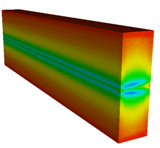This workshop will focus on collimators and beam absorbers for High Energy Hadron Accelerators, with the energy stored in the beams far above damage limit. The objective of the workshop is a better understanding of the technological limits imposed by mechanisms related to beam impact on materials. The issues to be addressed at the workshop are listed below.
Starts
Ends
Europe/Zurich
CERN
40-S2-D01
Geneva, Switzerland
- Alessandro BERTARELLI (CERN) - ORGANIZING COMMITTEE
- Caroline CAZENOVES (CERN) - Workshop Secretary
- Małgorzata MACUDA (CERN) - Workshop Secretary
- Nikolai V. MOKHOV (Fermilab) - ORGANIZING COMMITTEE
- Peter SPILLER (GSI) - ORGANIZING COMMITTEE
- Ralph W. ASSMANN (CERN) - ORGANIZING COMMITTEE
- Rudiger SCHMIDT (CERN) - Chairman
- Wim WETERINGS (CERN) - ORGANIZING COMMITTEE
WORKSHOP TOPICS:
• The problems encountered for systems used in different accelerators will be presented together with the solutions adopted. What materials are being used? What led to the choice of these materials? What are the limits of the present solutions?
• Why will more robust devices be needed in the future? What is the perspective in the framework of new or upgraded machines?
• The relevant parameters for beam impact on the material will be discussed, such as deposited beam energy, beam power and time structure of the beam impact.
• What material parameters are relevant, such as specific heat capacity, enthalpy, Young’s modulus, yield stress, coefficient of thermal expansion, thermal conductivity? What are the relevant figures of merit? Are the bulk or microscopic parameters the relevant ones, particularly for composite and anisotropic materials?
• What materials are most suitable, e.g. robust and with low electrical resistance? Other parameters such as anisotropy of materials and secondary electron yield? Are there new materials on the horizon?
• What happens in case of shock impact (time constant ~µs or ~ns) and continuous impact (time constant ~s)? What are the relevant physics effects to be considered?
• What are the limits of the domain of application of the classical thermoelastic/plastic theory with respect to the Hydrodynamic theory of Shock Waves?
• What happens to the material beyond melting / vaporisation temperature? (example: beam tunneling through materials).
• What is the design limit based on, e.g., maximum temperature? When do we require renewable/disposable/sacrificial devices?
• What is the status of the codes for energy deposition calculations? When do calculations for shock impact with mechanical engineering codes (e.g., ANSYS, AUTODYN, LS-DYNA) break down? What are the domains of validity for simulation?
• How to compare the results from different codes, possibly for some (simple) test cases to be defined?
• What experimental evidence and experience with benchmarking exists?
• How to formulate an equation of state for materials in advanced codes?
• What are the short- and long-term effects of radiation? What is the effect of the total dose on material properties, and on equation of state? Is there an effect of the dose rate?
• DPA (displacements per atom) is a measure of the material irradiation. Is this a universal measure for different radiation fields? Is there a temperature dependence during radiation? What about annealing? Can this be used to ‘repair’ devices?
• What tests of materials are possible? What to test? Where to test? How to analyse test results? Test bench at SPS?
• Material requirements for special concepts or locations, e.g. collimators and absorbers at cold or at intermediate temperature, collimators with superimposed magnetic fields, …
• What R&D is being done or is in the pipeline for investigating devices with special locations and concepts?




